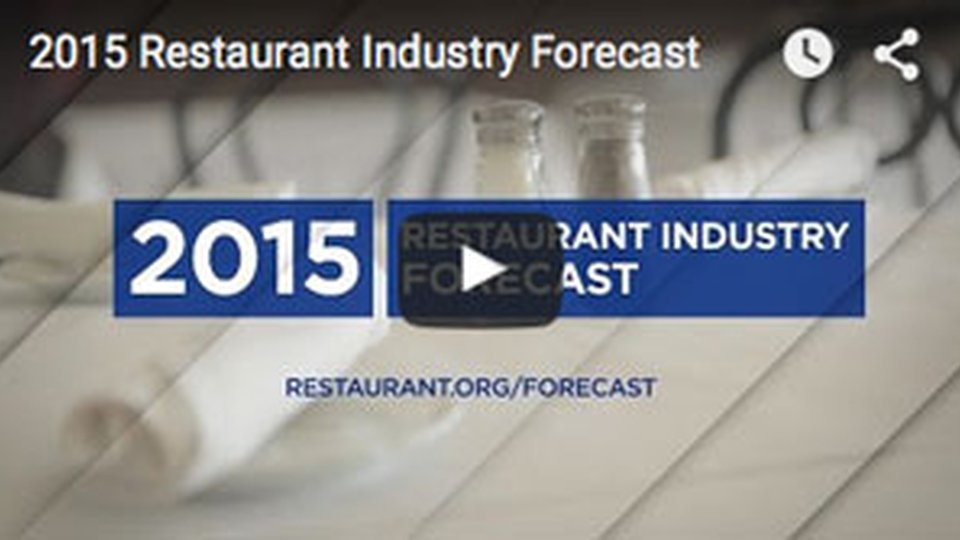News
NRA Projects Record Year For Restaurant Sales In 2015 7092 Billion

January 28, 2015
TAGS: bar business, restaurant trends, 2015 restaurant sales projections, restaurant forecast, National Restaurant Association, Hudson Riehle, restaurant sales growth, restaurant consumer-facing technology |
WASHINGTON -- Restaurant sales are expected to reach a record high of $709.2 billion in 2015, according to the National Restaurant Association's latest restaurant industry forecast, released on Jan. 27. While the operating environment will remain challenging, the projected 3.8% increase over 2014 would mark the sixth consecutive year of sales growth for the industry.
"With the economy slowly improving and national employment trending upward, signs are pointing in the right direction for restaurant industry growth," said NRA senior vice-president of research Hudson Riehle. "Certain components of the business climate remain a challenge, accelerating industry sales in some regions and putting a damper on them in others, but the overall industry is definitely in a better place now than several years ago."
Sales in the table-service segment are expected to reach $220 billion in 2015, a 2.9% gain over 2014 sales, while sales in the quick-service and fast-casual segment are projected to grow by 4.3% and reach $201 billion.
The top five states projected for restaurant sales growth in 2015 are Arizona, Florida, North Dakota, Texas and Colorado.
NRA's forecast indicates that consumers continue to have substantial pent-up demand for restaurant services. About 38% say they are not eating on the premises of restaurants as frequently as they would like, and 41% say they are not purchasing takeout or delivery as often as they would like.
Eight in 10 of consumers say restaurants offer more healthful menu options now compared to two years ago, and 76% say they are more likely to visit a restaurant that offers healthful choices. In addition, 67% of consumers say they order more healthful options in restaurants than they did two years ago.
Consumers are showing increased interest in local sourcing and more restaurants are taking notice, with eight in 10 table-service operators saying their guests are more interested in locally sourced items this year, compared with seven in 10 that said the same a year earlier.
Roughly one-quarter of consumers say technology factors into their decision to choose a restaurant, up from the nearly one-fifth that said the same last year. While restaurants are more rapidly starting to adopt various forms of consumer-facing technology to increase speed and convenience, a gap remains between what consumers want and what restaurants currently offer, according to NRA. That gap is reportedly beginning to narrow and will further close over the next several years as restaurant technology evolves and more options enter the marketplace.
NRA also predicts that 2015 will mark the 16th consecutive year in which restaurant industry employment will outpace overall employment growth. Eating and drinking places -- the largest subcategory of the foodservice industry -- are projected to add jobs at a 3.2% rate in 2015, a full percentage point above the projected 2.2% gain in total U.S. employment.
In addition, the NRA projects that restaurant industry employment will reach 15.7 million by 2025, an increase of 1.7 million positions during the 10-year period. Over that decade, the top five states for restaurant employment growth are Arizona, Florida, Texas, Georgia and Utah.
While the restaurant industry is expected to grow this year, operators will continue to face a range of challenges, according to the NRA's forecast.
Average wholesale food prices jumped more than 5% in 2014, which represented the fifth consecutive annual increase. During the last five years, average wholesale food prices rose roughly 25%. Operators, however, can expect to get pricing relief on several of the major commodities in 2015, including dairy and pork.
Another challenge with the economy steadily improving and the jobless rate trending downward, is that restaurant operators are finding that the competition for employees is intensifying.
Labor costs will remain a concern for operators in 2015. Challenges with the Affordable Care Act's implementation and minimum wage increases have made a significant impact on restaurant bottom lines, as typically one-third of restaurant sales are spent on labor.


